WASHINGTON, D.C. -- Gallup's daily measure of U.S. employment reveals that 19.9% of the U.S. workforce was underemployed during the month of January, translating to close to 30 million Americans who are working less than their desired capacity. Those who were underemployed reported spending 36% less than those who were employed, $48 per day versus $75 per day.
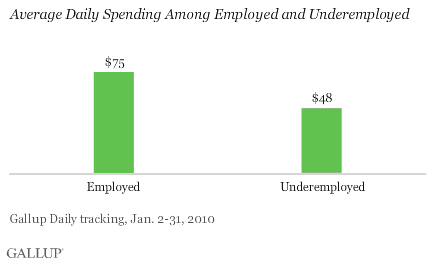
These results are based on January interviews with more than 20,000 adults in the U.S. workforce, aged 18 and older. Gallup classifies respondents as "employed" if they are employed full time or are employed part time but do not want to work full time. Gallup classifies respondents as "underemployed" if they are employed part time but want to work full time or are unemployed.
"The underemployed are less likely than the employed to say they are able to make a major purchase, such as a car or home repair, if needed."
As unemployment rates remain high, reduced spending by millions of underemployed Americans has obvious implications for economic recovery. Spending is, however, just one of many ways underemployment costs the U.S. and hurts its workforce. Gallup's employment measure also reveals further disparities between the employed and the underemployed on vital indicators such as attitudes toward money, access to healthcare, demographics, and wellbeing.
Personal Finances
Underemployment is generally associated with a less-than-desired income, and Gallup data highlight the stark contrast in spending attitudes between the employed and the underemployed. Sixty percent of employed respondents feel good about the amount of money they have to spend, while only half as many (29%) of the underemployed report feeling good. Further, the underemployed are less likely than the employed to say they are able to make a major purchase, such as a car or home repair, if needed (25% vs. 58%, respectively).
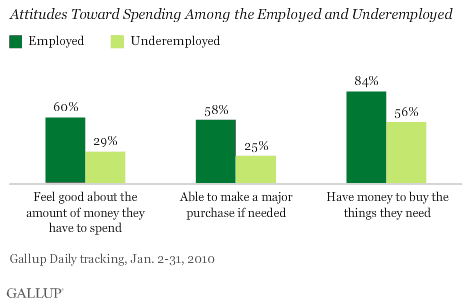
Particularly noteworthy are the differences in the groups' reported ability to afford basic necessities. Slightly more than half (56%) of underemployed respondents say they have enough money to buy the things they need, compared to 84% of employed respondents.
Additionally, respondents who are underemployed are more likely to report that they did not have enough money for food, shelter, or healthcare at some time during the past 12 months.
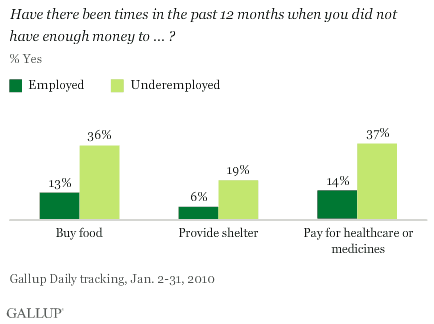
Healthcare
Access to preventative care and health insurance also differ between the employed and the underemployed, illustrating the strain that high underemployment can place on the healthcare system. The underemployed are less likely than the employed to have health insurance (59% vs. 87%, respectively), to have had enough money for healthcare (63% vs. 85%), to have a personal doctor (63% vs. 81%) or to have visited a dentist in the last 12 months (57% vs. 72%).
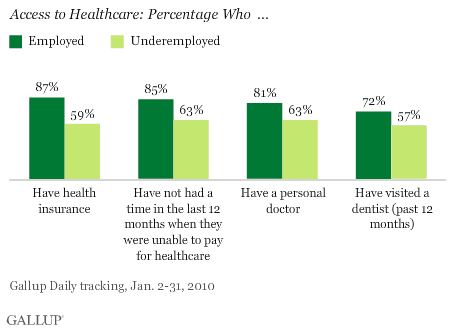
Demographics
There are several important demographic differences between the employed and the underemployed. While numerous reports have highlighted men's struggles to find employment during the current economic downturn, Gallup data indicate that underemployment levels among women (21%) are similar to those among men (19%).
Adults aged 18 to 29 are almost twice as likely (31%) to be underemployed as 30- to 49-year olds (17%) and 50- to 65-year-olds (17%) are.
Underemployment declines with increasing education levels. While nearly 4 in 10 respondents (38%) with less than a high school diploma are underemployed, the figure drops to 12% among those with a four-year college degree and further to 10% for those with education beyond college.
Among racial and ethnic groups, blacks (27%) and Hispanics (29%) are most likely to be underemployed, while non-Hispanic whites (17%) are least likely.
Taken as a whole, the employment status of certain demographic groups is bleak. Gallup's data illustrate that full employment is not available to all U.S. workers, and opportunities for employment are in short supply for American youth and minorities.

Presidential Approval
Employment status is related to a number of political and ideological variables. As one example, underemployed Americans (55%) are more likely than the employed (48%) to approve of the way Barack Obama is handling his job as president. During the same time period, 49% of the American population approved of Obama's job performance. As a point of reference, among the employed, 29% identify themselves as Republicans, 31% as Democrats, and 33% as independents. Twenty-two percent of the underemployed identify as Republicans, 34% as Democrats, and 35% as independents.
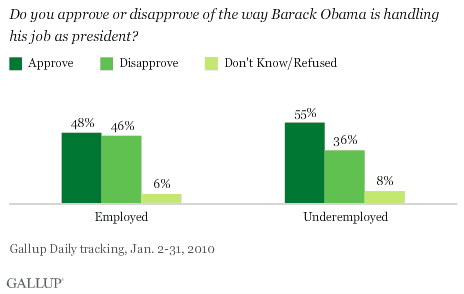
Wellbeing
Individuals who are employed (60%) are more likely than the underemployed (40%) to be classified by Gallup as "thriving." Those who are thriving respond affirmatively to present- and future-circumstance questions based on the Cantril Self-Anchoring Striving Scale, which asks respondents to evaluate their present and future lives on a ladder scale, with steps numbered from 0 to 10. By comparison, 53% of the U.S. population in general was classified as thriving during the same period.
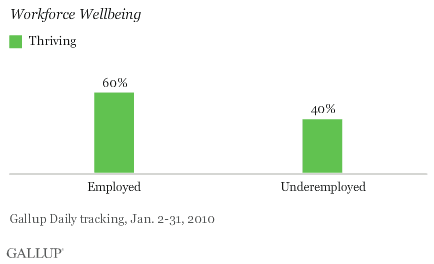
Bottom Line
Gallup data spotlight the stressors faced by 30 million underemployed Americans. Underemployed Americans report spending 36% less than their employed counterparts on average, potentially costing the U.S. economy hundreds of millions of dollars as underemployment continues to remain high. Compared with employed respondents, underemployed respondents also report greater difficulty in affording basic necessities, have lower levels of access to healthcare, have less satisfaction with their financial resources, and evaluate their lives less favorably.
Learn more about Gallup's economic measures.
Survey Methods
Results are based on telephone interviews with 20,503 national adults, aged 18 and older, conducted Jan. 2-31, 2010, as part of Gallup Daily tracking. For results based on the total sample of national adults, one can say with 95% confidence that the maximum margin of sampling error is ±1 percentage point.
Interviews are conducted with respondents on land-line telephones (for respondents with a landline telephone) and cellular phones (for respondents who are cell-phone only).
In addition to sampling error, question wording and practical difficulties in conducting surveys can introduce error or bias into the findings of public opinion polls.
